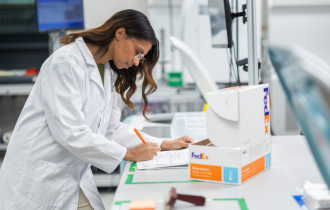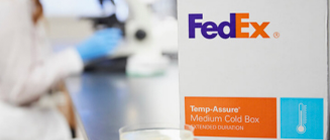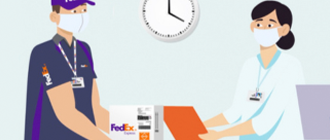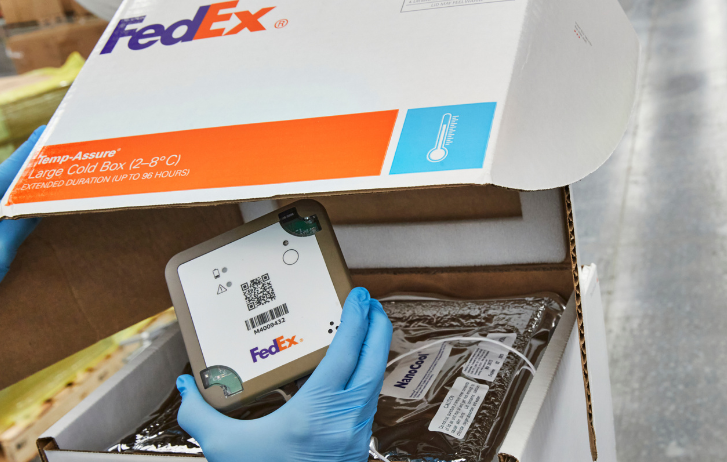
How Technology Is Shaping The Future Of Healthcare Logistics
By Salil Chari | First published: July 19, 2023 Updated: April 4, 2025
From near-real-time data to AI-driven prediction software, digital technologies are central to how we move medical supplies and healthcare products safely and quickly.
- AI, sensors, blockchain: An expanding suite of evolving technologies is driving major breakthroughs in healthcare.
- Smart technologies in healthcare shipping are enabling both pharma companies and patients to benefit from end-to-end visibility throughout the supply chain.
- FedEx’s Salil Chari unpacks the healthcare logistics trends driving customer experience and transforming healthcare in Asia.
One of the most positive health news stories this year was a major scientific breakthrough that allows people with paralysis to touch and feel objects using a robotic arm. More recently, advanced research into the possibility of cancer vaccines has been making headlines around the world.
Not every healthcare breakthrough gets such public attention. Sometimes, the most important developments happen behind the scenes. The same is true in the logistics industry, which was largely invisible until the COVID outbreak.
The pandemic brought the world’s reliance on transportation infrastructure into sharp focus. It also showcased the potential of digital technologies to streamline the process of moving lifesaving supplies and delicate pharmaceutical products.
These include solutions that leverage near-real-time data and AI to predict problems like traffic congestion and weather events, triggering proactive measures to prevent delays. Blockchain, which created the cryptocurrency industry and is now redefining financial services, is also making waves in the logistics sphere.
When it comes to tech in healthcare, connectivity is key
These days, customers shipping sensitive pharmaceutical products are looking for more information than standard package tracking. Whether their concern is higher security, quality assurance, or enhanced visibility into the package’s journey, obtaining an accurate, real-time picture is essential.
Smart devices that combine next-generation sensor technology with GPS and location-based services are making this possible. They can instantly tell carriers and their customers precisely where a package is, the local environmental conditions such as temperature and humidity, and even issue alerts if something has been dropped or opened.
Developed by our healthcare team, the FedEx SenseAware shipment monitor uses a multi-sensor device, typically placed inside packages, pallets, trailers and warehouses. It collects data from the moment a shipment is packed to the second it’s delivered.
It’s a level of detail that’s essential for healthcare and pharmaceutical businesses with strict quality, security and compliance requirements.
Perhaps more importantly, SenseAware allows the data to be shared dynamically in near-real-time. For instance, a hospital could track urgently needed packages right to its front door, allowing doctors to organize preparations and time medical procedures almost to the minute.
A new era of smart technologies in healthcare shipping
Taking action in real-time makes an immediate difference. Using data pre-emptively opens up even more possibilities. It allows logistics carriers to analyze data to identify trends, predict issues and avoid potential pitfalls before they become problems.
That’s exactly what we are focusing on. Throughout the pandemic, we leveraged FedEx Surround, our monitoring and intervention solution, to monitor vaccine transportation. Today, we use FedEx Surround to provide near-real-time visibility across healthcare, aerospace and high-tech industries, including for customers shipping high-value goods.
We’re now able to provide more visibility into delivery lead times and warehouse inventory levels across the whole network. This approach has also helped us identify specific opportunities to streamline shipping and improve the experience for our customers.
Enabling efficiency, increasing transparency and trust
As groundbreaking as these technologies are, they’re only just scratching the surface. Sensors already capture and upload operational data minute by minute. Imagine if that information was also uploaded to a blockchain that guarantees the data can’t be changed or manipulated.
According to Deloitte, the promise of blockchain has widespread implications for stakeholders across the healthcare ecosystem. As well as securing patient data, it can improve efficiency and support better health outcomes for patients.
The decentralized nature of blockchain also makes offering full transparency in the shipping process a realistic possibility. This opens the door for even more innovations, such as speeding up cross-border transportation, tackling security issues like digital fraud, and providing a common language to interconnect the systems of different healthcare organizations and supporting industries.
In the healthcare sector, these innovations can make a genuine contribution to saving lives. Although logistics technology might not capture mainstream headlines this year, it will certainly be making a major difference across the entire healthcare spectrum.
The result is a stronger, more resilient ecosystem that offers significant advantages – not only for the organizations using the platform, but the people they serve.
SHARE THIS STORY
- How To Ship A Giant Panda
- How To Make Freight Shipments Work For Your Small Business
- The Rise Of Intra-Asia Trade: Opportunities In The China-Southeast Asia Corridor
- Southeast Asia: The Next Manufacturing Powerhouse?
- 8 Most Unusual Shipments In The History Of FedEx
- Where Do Old Planes Go When They Retire?
Sign up now and save on your shipping rates!
Sign up now and earn discounts by shipping instantly with FedEx Ship ManagerTM at fedex.com.
Recommended For You

Why Logistics Innovations Are Important To Fight The Next Pandemic
The industry is using lessons learned to help eliminate underlying healthcare vulnerabilities and improve speed and efficiency of relief efforts.
Read More
How To Ship A Clinical Trial Sample
When it comes to shipping biological samples for clinical trials, every second counts.
Read More
How Can Technology Deliver Superior Customer Service?
Logistics technology can help small businesses connect with their customers in new ways. Kawal Preet shares how healthcare businesses can grow.
Read More

